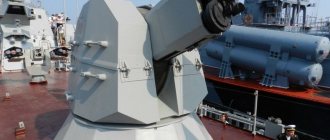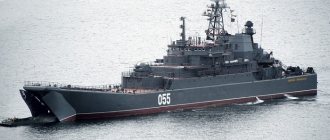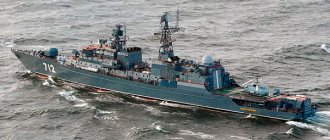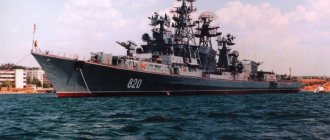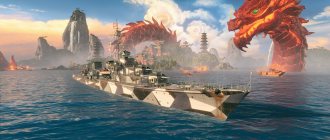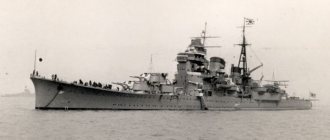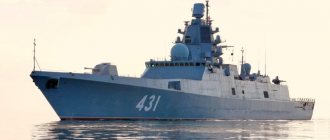“Ivan Tarawa” – a hostage of admirals and politicians
As part of the development of the landing forces of the USSR Navy, which required a larger and more versatile (multi-mission) ship than the BDK Project 1174 available at that time, as stated by the instructions of the Commander-in-Chief of the Navy, Admiral of the Fleet of the Soviet Union Sergei Gorshkov, specialists of the Nevsky Design Bureau approximately in the middle In the 1980s, work began on the possibility of creating a landing ship of a new class for the country - the universal landing ship (UDC) of Project 11780, which had a docking chamber for receiving landing craft and was capable of carrying a sufficiently large air group, for which the ship had to have a solid , along the entire length, a large flight deck. The promising ship was supposed to land personnel and equipment using helicopters and landing boats, as well as through bow and stern ramps. In the process of its design, it was supposed to take into account individual developments on aircraft-carrying cruisers of the Kyiv type.
Due to the fact that the conceptually promising Soviet UDC was largely the same as the American UDC of the “Tarawa” type, the nickname “Ivan Tarawa” quickly became established behind it. On the other hand, the Nevsky Design Bureau carried out development of the ship not only in the classic UDC version, including a sub-variant with the inclusion of vertical take-off and landing (VTOL) aircraft of the Yak-38 type in the ship's air group, but also in the version of an anti-submarine ship (helicopter carrier). It was planned to build two ships - “Kherson” and “Kremenchug”.
The initial, “pure landing” version of the ship provided for a continuous flight deck measuring 200x25 m, which could be used for the production and reception of both Ka-29 type airborne transport helicopters (12 helicopters in the ship’s air group) and Yak-38 type aircraft. The helicopters were to be used to deliver landing personnel to the coast and provide them with fire support. Later, in the anti-submarine version, the possibility of basing on the ship twice as many – up to 25 vehicles – the number of Ka-27 anti-submarine helicopters was spelled out.
All weapons, which included one two-gun AK-130 artillery mount of 130 mm caliber, one battery of the Kinzhal anti-aircraft missile system (SAM) consisting of three or six eight-charge drum-type vertical launch systems (UVP) and an anti-aircraft missile and artillery system (ZRAK) " Dirk" consisting of two to four combat modules, and various radio equipment (radar antenna posts, electronic warfare equipment, etc.) were located in the island superstructure, which was shifted to the starboard side.
The project provided for the presence on the ship of a sufficiently capacious docking chamber, where landing boats could be placed (four or five displacement boats of Project 1176 or two or three hovercraft of Project 1206) and through which landing amphibious equipment could be landed afloat. The design of the UDC also included bow and stern ramps.
Project 11780 UDC had the following design tactical and technical elements: normal displacement - 25 thousand tons, full displacement - more than 30 thousand tons, maximum length - 196 m, ship waterline length (WL) - 180 m, maximum width - 35 m , beam along the vertical line - 25 m, draft - 8 m, autonomy in terms of fuel, water and provisions - 30 days.
Boiler-turbine main power plant (GEM) with a capacity of 100 thousand liters. With. (according to other sources, even 180 thousand hp / 142.4 MW) was supposed to be unified with the power plant of Project 956 destroyers and was supposed to provide the ship with a full speed of 30 knots, as well as an economic cruising range of 18 knots up to 8000 miles .
Landing capacity - up to 1000 personnel plus about 70 units of various military and automotive equipment or 40 main tanks and 15 armored personnel carriers.
However, the development of the Project 11780 UDC was ultimately stopped at the design stage.
Domestic naval historians agree that the Project 11780 UDC became hostage to the “confrontation” that took place between the Commander-in-Chief of the USSR Navy, Admiral of the Fleet of the Soviet Union Sergei Georgievich Gorshkov, and the Deputy Chief of the General Staff of the USSR Armed Forces for the Navy, Admiral Nikolai Nikolaevich Amelko. The latter had previously been Gorshkov’s deputy for anti-submarine defense (ASD), but, it is believed, was forced to transfer to the General Staff due to insurmountable disagreements with the Commander-in-Chief. Russian specialized literature indicates that, not without the influence of Admiral Amelko, when considering Project 11780, the leadership of the General Staff proposed to modify the ship - to place a springboard in the bow and to additionally support other types of aircraft on the ship.
It is alleged that Sergei Gorshkov considered that the implementation of such a “request” would benefit a group of high-ranking opponents of the Soviet aircraft carrier program, which is believed to have included Admiral Nikolai Amelko. And as a preventive measure, Sergei Georgievich instructed the designer to move the two-gun 130-mm artillery mount and two batteries of the Kinzhal anti-aircraft missile system, six UVPs in each, from the superstructure to the bow - to where the springboard proposed by the General Staff would be located. In addition, the basing of VTOL aircraft was no longer provided for. Naval science was ordered to “scientifically substantiate” the need for such changes, which was done. However, in this form the General Staff no longer needed the ship.
It should be especially noted that there were problems with choosing a place to build ships of such displacement and size. At that time it was possible to build them only at the Black Sea Shipyard in Nikolaev. But the latter was then the main character in the Soviet aircraft carrier program, and the shipyard would not have been able to carry both classes of ships. Domestic sources indicate that if the plant was obliged to build, in addition to aircraft-carrying cruisers, two more UDCs, the labor intensity of each of which reached 13 million man-hours, both of these programs could be in jeopardy.
Moreover, the leadership of the General Staff of the USSR Armed Forces proposed building UDCs to replace TAVKRs. But since the latter were of higher priority for the Navy command, the admirals did everything possible to get the General Staff and the leadership of the Ministry of Defense to abandon the idea of UDC altogether. And then another important reason for the termination of work on Project 11780 appeared: the Soviet Union collapsed, and the leadership of the new Russia had no time for the ocean-going fleet with its aircraft carriers and universal landing ships.
Another attempt to give the fleet a full-fledged universal landing ship - in the form of an improved landing helicopter dock ship of the Mistral type - was made already in the new millennium. However, also to no avail. Now all hopes are pinned on the Priboi-type UDC. The future will show how reasonable and realistic they are in implementation in practice.
"Softening" the defense
In the two days preceding the landing, carrier-based aircraft and cruisers alone dropped more than 430 tons of bombs and shells on the atoll. It would seem that there should be nothing alive left on the tiny island. However, as the invasion force approached Tarawa at dawn of D-Day, November 20, 1943, it was greeted by vigorous fire from coastal artillery.
The position of one of the batteries of 203-mm coastal guns after the capture of Tarawa.
They managed to suppress it with the main fire of the battleships, after which the guns of cruisers and destroyers took over, and then the assault attack of carrier-based aircraft began. Meanwhile, the landing craft were already reaching their starting lines.
So far everything was going according to plan...
Gallery
- Tarawalha1.jpg
- US Navy 040728-N-4459K-004 Crew members aboard the amphibious assault ship USS Nassau (LHA 4) create formation lettering on the flight deck spelling out.jpg
- Amphibious assault ship USS Belleau Wood (July 7 2004).jpg
- USS Pelelui from air.jpg
- USS Nassau (LHA-4) and RFA Bayleaf (A109).jpg
- Peleliu2.jpg
- USS Peleliu (LHA 5) in South China Sea 02.jpg
- USS Peleliu (LHA 5) in South China Sea 01.jpg
- Pakistani Navy frigate PNS Badr.jpeg
- Bwandlandingcraft.jpg
- USS Bonhomme Richard (LHD-6) welldeck.jpg
- Helcarrier2.JPG
- Saipan battle group.jpg
- USS Peleliu LHA5.jpg
- USS Peleliu (LHA 5) in South China Sea 04.jpg
- USS Peleliu (LHA 5) in South China Sea 05.jpg
External links [edit]
| Wikimedia Commons has media related to Tarawa-class amphibious assault ships . |
- USS Tarawa (LHA-1) Landing Craft Museum
| vteTarawa class amphibious assault ships | |
| |
| |
| |
Construction[edit]
All five ships were built by Ingalls Shipbuilding at that company's Pascagoula, Mississippi shipyard. [1] Tarawa
was approved for construction during fiscal year 1969, and Congress ordered two more ships of the class in fiscal years 1970 and 1971. [1]
Design problems arose early in the LHA program and, contrary to the intent of the integrated acquisition concept, the Navy became heavily involved in the design process. [4] Nine ships were initially hired for the Tarawa
, but this number was reduced to five in January 1971. [4] The remaining four ships were never built for the Navy. [1]
Work on the first warship of the class, USS Tarawa, began on November 15, 1971, and she was commissioned on May 29, 1976. [1] The last of the five ships, USS Peleliu, was completed on May 3, 1980. [1]
Disembarkation
In the opening scenes of Saving Private Ryan, the ramp of the LCVP Higgins landing craft swings open and the men pour ashore, where they come under daggering machine-gun fire. “Get off the beach!” In fact, both on Omaha Beach and on Tarawa Atoll, everything was completely different. Less dynamic, but more bloody.
Ahead is Tarawa. Marines aboard the LCVP landing craft Higgins. He won't reach the shore
In both cases, the Higgins were unable to deliver the paratroopers to the shore. In the case of Tarawa, the landing time occurred at a “quadrature tide,” when the water level rises 60 centimeters less than usual. This was enough for the boats to get stuck on the reefs 450-900 meters from the beaches, where Japanese artillery and heavy machine guns immediately began to “disassemble” them. And the Marines had to dismount and slowly wade towards the shore in neck-deep water. Under heavy machine gun fire.
Disembarkation from tracked floating conveyors LVT "Alligator"
Luckily for them, 87 more “Amtraks” - floating LVT transporters - took part in the landing. Thanks to the tracks, they were able to cross the reefs and move towards the beaches. Most of the vehicles managed to reach the shore, where they ran into anti-tank barriers.
The advanced units, having suffered heavy losses, found themselves squeezed into three tiny spots, where they began to be ironed out by mortars.
Links[edit]
- Bishop, Chris; Chant, Christopher (2004). Aircraft Carriers: The World's Greatest Warships and Their Aircraft. London: MBI. ISBN 0-7603-2005-5. OCLC 56646560.
- Sharp, Richard, ed. (1998). Jane's Fighting Ships 1998–99
(101st ed.). Coulsdon, Surrey: Jane Information Group. ISBN 0-7106-1795-X. OCLC 39372676. - Wertheim, Eric, ed. (2007). The Naval Institute's Guide to the World's Combat Fleets: Their Ships, Aircraft, and Systems (15th ed.). Annapolis, MD: Naval Institute Press. ISBN 978-1-59114-955-2. OCLC 140283156.
Quotes [edit]
- ^ abcdefghijklmnopqrstu Sharp (ed.), Jane's Fighting Ships 1998–99
, p. 822 - ^ ab Bishop and Chant, Aircraft Carriers
, p. 230 - ^ ab Wertheim (ed.), The Naval Institute's Guide to the World's Combat Fleets
, p. 921 - ^ ab Two Navy Ship Contracts Modified by Public Law 850804 - Accessed July 29, 1979 (PDF). Washington, DC: General Accounting Office. July 29, 1979 p. 1 . Retrieved January 4, 2016.
- "US NAVY Fact File - CHARM SHIPS - LHA/LHD/LHA(R)". Retrieved May 23, 2014.
- "Decommissioning of US Navy Peleliu". naval-technology.com. April 2, 2015. Retrieved June 25, 2015.
Ships in class[edit]
| Name | Case number | Put it down | Launched | Commissioned | Decommissioned | Fate |
| Tarawa | LHA-1 | November 15, 1971 | December 1, 1973 | May 29, 1976 | March 31, 2009 | Requested as a museum ship |
| Saipan | LHA-2 | July 21, 1972 | July 18, 1974 | October 15, 1977 | April 25, 2007 | Slom 2009 |
| Belleau Wood (formerly Philippine Sea ) | LHA-3 | March 5, 1973 | April 11, 1977 | September 23, 1978 | October 28, 2005 | Sunk as target ship July 13, 2006 |
| Nassau (formerly Leyte Gulf ) | LHA-4 | August 13, 1973 | January 21, 1978 | July 28, 1979 | March 31, 2011 | In reserve |
| Peleliu (ex- Danang , ex- Khe Sanh ) | LHA-5 | November 12, 1976 | November 25, 1978 | May 3, 1980 | March 31, 2015 | In reserve |
Decommissioning and replacement[edit]
Main article: America-class amphibious landing ship
Tarawa
since retirement from service began in 2005. In April 2011, four of the five amphibious assault ships were withdrawn from service, leaving only
Peleliu
in active service.
[5] Peleliu
was decommissioned on March 31, 2015 in San Diego. [6]
Tarawa class
should be replaced by America's class.
[3] The first American-
class vessel was delivered and commissioned in 2014.


